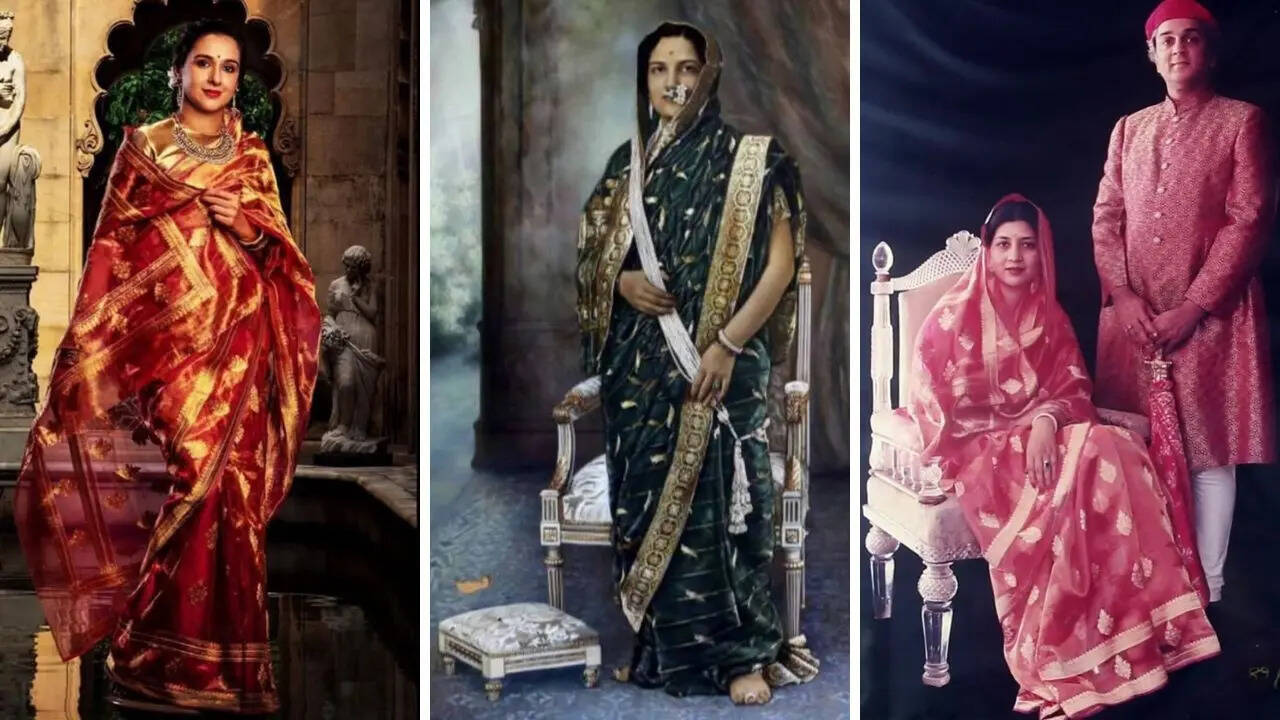Lifestyle
Maharani Radhika Raje Scindia Revives the Baroda Shalu Saree

The Baroda Shalu saree, once a symbol of Maratha royal heritage, is experiencing a revival led by Maharani Radhika Raje Scindia. After fading into obscurity in the 1970s, this exquisite textile, traditionally woven for the women of the Maratha nobility, is being brought back to life through a collaboration with textile and embroidery artist Asif Shaikh and master weaver Saeedur Rahman.
The Baroda Shalu, characterized by its fine gossamer cotton and delicate tissue, is reminiscent of the more widely known Chanderi sarees. It features intricate motifs and craftsmanship that set it apart. This saree was historically reserved for royal celebrations, weddings, and significant family events, showcasing the artistry of skilled weavers. Maharani Radhika has been actively documenting and sharing rare heirloom pieces, highlighting the garment’s royal lineage and cultural significance.
In a recent Instagram post, Radhikaraje noted, “Baroda Shalu, one of the least known and researched textiles of royal India, received its patronage and thus its name from the Royal Gaekwads of Baroda.” She emphasized its exclusivity, indicating that its visual history is primarily captured through the experiences of Maharani Shantadevi and her family, particularly during the Raj Abhishek, or coronation, of her husband, Maharaja Pratapsinh Gaekwad, in 1939.
The production of the Baroda Shalu dwindled after Indian independence, as the royal patronage that supported its craftsmanship disappeared. The demand for such a specialized textile diminished, leading many master weavers to abandon their craft. The rise of machine-made fabrics and the increasing costs of authentic zari and specialized yarns further complicated the situation. By the 1970s, the Baroda Shalu had become a rarity, existing only in a few heirloom collections.
The revival effort began in earnest in 2019. With the expertise of Asif Shaikh and Saeedur Rahman, the Baroda Shalu has found its way back into the public eye. Radhikaraje’s contemporary engagement with this textile is not just about preserving history; it is about inspiring a new generation to appreciate and embrace this unique craft.
The renewed interest in the Baroda Shalu also highlights the broader implications for the textile industry in India. As younger generations gravitate towards commercial weaving hubs like Benaras and Chanderi, preserving traditional crafts becomes increasingly vital. Radhikaraje’s mission serves as a reminder of the rich cultural tapestry that textiles like the Baroda Shalu represent.
As she wears a vintage Baroda Shalu saree woven in real gold, Radhikaraje is not only celebrating her heritage but also igniting interest in a textile that once adorned the royal courts of India. The journey of the Baroda Shalu is a testament to the resilience of craft and culture, ensuring that this beautiful saree continues to be appreciated for generations to come.
-

 World4 months ago
World4 months agoSBI Announces QIP Floor Price at ₹811.05 Per Share
-

 Lifestyle4 months ago
Lifestyle4 months agoCept Unveils ₹3.1 Crore Urban Mobility Plan for Sustainable Growth
-

 Science3 months ago
Science3 months agoNew Blood Group Discovered in South Indian Woman at Rotary Centre
-

 World4 months ago
World4 months agoTorrential Rains Cause Flash Flooding in New York and New Jersey
-

 Sports3 months ago
Sports3 months agoBroad Advocates for Bowling Change Ahead of Final Test Against India
-

 Top Stories4 months ago
Top Stories4 months agoKonkani Cultural Organisation to Host Pearl Jubilee in Abu Dhabi
-

 Science4 months ago
Science4 months agoNothing Headphone 1 Review: A Bold Contender in Audio Design
-

 Top Stories4 months ago
Top Stories4 months agoAir India Crash Investigation Highlights Boeing Fuel Switch Concerns
-

 Sports3 months ago
Sports3 months agoCristian Totti Retires at 19: Pressure of Fame Takes Toll
-

 Business4 months ago
Business4 months agoIndian Stock Market Rebounds: Sensex and Nifty Rise After Four-Day Decline
-

 Politics4 months ago
Politics4 months agoAbandoned Doberman Finds New Home After Journey to Prague
-

 Top Stories4 months ago
Top Stories4 months agoPatna Bank Manager Abhishek Varun Found Dead in Well









